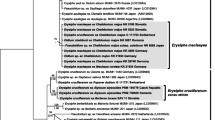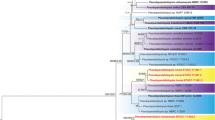Abstract
Oomycetes contain some of the economically most important pathogens of flowering plants. Most have a rather narrow host range, often being restricted to single host species. In downy mildews and other obligate biotrophic plant parasites, like powdery mildews and rusts, delimitating species on grounds of morphological characteristics is often hardly possible and thus often based on only subtle differences. This has led to the widespread application of a broad species concept for these organisms. Consequently, despite the fact that morphological differences were reported for Pseudoperonospora cubensis from different host species, the corresponding new pathogen species were not accepted as being independent, and the host range of Pseudoperonospora cubensis is reported to encompass more than 50 host species in the Cucurbitaceae in temperate to tropical climates. However, recent studies have reported narrow host ranges for other downy mildew genera and advocated a narrow species concept. Here, we report successful colonisation of five different tribes of the Cucurbitaceae by a strain of Pseudoperonospora cubensis and demonstrate that the host matrix has a major impact on the morphology of the pathogen. On the basis of five morphological criteria significant differences could be found for all hosts. These differences were more pronounced in phylogenetically unrelated than in related hosts. Our results provide evidence for a broad host range of Pseudoperonospora cubensis and demonstrate that species delimitation based on morphological characters is not feasible in Pseudoperonospora on Cucurbitaceae. Also in other biotrophic plant pathogens, the situation could be similar, thus necessitating thorough morphological, molecular phylogenetic and cross inoculation experiments for species recognition.



Similar content being viewed by others
References
Bains, S. S., & Jhooty, J. S. (1978). Relationship between mineral nutrition of muskmelon and development of downy mildew caused by Pseudoperonospora cubensis. Plant and Soil, 49, 85–90.
Blair, J. E., Coffey, M. D., Park S.-Y., Geiser D. M., & Kang S. (2008). A multi-locus phylogeny for Phytophthora utilizing markers derived from complete genome sequences. Fungal Genetics and Biology, 45, 266–277.
Brandenburger, W. (1985). Parasitische Pilze an Gefäßpflanzen in Europa. Stuttgart: Gustav-Fischer.
Choi, Y.-J., Hong, S.-B., & Shin, H.-D. (2005). A re-consideration of Pseudoperonospora cubensis and P. humuli based on molecular and morphological data. Mycological Research, 109, 841–848.
Choi, Y.-J., Hong, S.-B., & Shin, H.-D. (2007a). Re-consideration of Peronospora farinosa infecting Spinacia oleracea as distinct species, Peronospora effusa. Mycological Research, 110, 381–391.
Choi, Y.-J., Shin, H.-D., Hong, S.-B., & Thines, M. (2007b). Morphological and molecular discrimination among Albugo candida materials infecting Capsella bursa-pastoris world-wide. Fungal Diversity, 27, 11–34.
Choi, Y.-J., Shin, H.-D., Ploch, S., & Thines, M. (2008). Evidence for uncharted biodiversity in the Albugo candida complex, with the description of a new species. Mycological Research, 112, 1327–1334.
Choi, Y.-J., Shin, H.-D., & Thines, M. (2009a). Two novel Peronospora species are associated with recent reports of downy mildew on sages. Mycological Research, 113, 1340–1350.
Choi, Y.-J., Shin, H.-D., & Thines, M. (2009b). The host range of Albugo candida extends from Brassicaceae over Cleomaceae to Capparaceae. Mycological Progress, 8, 329–335.
Cohen, Y. (1981). Downy mildew of cucurbits. In D. M. Spencer (Ed.), The downy mildews (pp. 341–354). London: Academic.
Crute, I. R. (1981). The host specifity of peronosporaceous fungi and the genetics of the relationship between host and parasite. In D. M. Spencer (Ed.), The downy mildews (pp. 237–253). London: Academic.
Cunnington, J. H. (2006). DNA sequence variation supports multiple host-specialised taxa in the Peronospora viciae complex (Chromista: Peronosporales). Nova Hedwigia, 82, 23–29.
Delanoe, D. (1972). Biologie et Epidemiologie du mildiou du tournesol. CETIOM Informations Techniques, 26, 1–61.
Dick, M. W. (2001). Straminipilous fungi: Systematics of the peronosporomycetes including accounts of the marine straminipilous protists, the plasmodiophorids and similar organisms. Dordrecht: Kluwer Academic Publishers.
Dudka, I. O., Anishchenko, I. M., & Terent’eva, N. G. (2007). The variability of Peronospora alta Fuckel conidia in dependence on the ecological conditions. In A. Lebeda & P. T. N. Spencer-Phillips (Eds.), Advances in downy mildew research, vol. 3 (pp. 39–46). Kostelec na Hané (Czech Republic): Palacký University in Olomouc and JOLA.
García-Blázquez, G., Göker, M., Voglmayr, H., Martín, M. P., Tellería, M. T., & Oberwinkler, F. (2008). Phylogeny of Peronospora, parasitic on Fabaceae, based on ITS sequences. Mycological Research, 112, 502–512.
Gäumann, E. (1918). Über die Formen der Peronospora parasitica (Pers.) Fries. Ein Beitrag zur Speziesfrage bei den parasitischen Pilzen. Botanisches Centralblatt, Beihefte, 35, 395–533.
Gäumann, E. (1923). Beiträge zu einer Monographie der Gattung Peronospora Corda. Beiträge zur Kryptogamenflora der Schweiz, 5, 1–360.
Göker, M., Voglmayr, H., García-Blázquez, G., & Oberwinkler, F. (2009). Species delimitation in downy mildews: the case of Hyaloperonospora in the light of nuclear ribosomal ITS and LSU sequences. Mycological Research, 113, 308–325.
Holmes, G. J., Main, C. E., & Keever, Z. T., III. (2004). Cucurbit downy mildew: A unique pathsystem for disease forecasting. In P. T. N. Spencer-Phillips & M. Jeger (Eds.), Advances in downey mildew research, vol. 2 (pp. 69–80). Dordrecht: Kluwer.
Iwata, Y. (1942). Specialization in Pseudoperonospora cubensis (Berk. et Curt.) Rostov. II. Comparative studies of the morphologies of the fungi from Cucumis sativus L. and Cucurbita moschata Duchesne. Annals of the Phytopathological Society of Japan, 11, 172–185.
Iwata, Y. (1953). Specialization in Pseudoperonospora cubensis (Berk. et Curt.) Rostov. IV. Studies on the fungus from Oriental pickling melon (Cucumis melo var. conomon Makino). Bulletin of the Faculty of Agriculture, Mie University, 1, 30–35.
Kocyan, A., Zhang, L. B., Schaefer, H., & Renner, S. S. (2007). A multi-locus chloroplast phylogeny for the Cucurbitaceae and its implications for character evolution and classifcation. Molecular Phylogenetics and Evolution, 44, 553–577.
Komjáti, H., Walcz, I., Virányi, F., Zipper, R., Thines, M., & Spring, O. (2007). Characteristics of a Plasmopara angustiterminalis isolate from Xanthium strumarium. European Journal of Plant Pathology, 119, 421–428.
Lebeda, A. (1991). Resistance in muskmelons to Czechoslovak isolates of Pseudoperonospora cubensis from cucumbers. Scientia Horticulturae, 45, 255–260.
Lebeda, A., & Widrlechner, M. P. (2003). A set of Cucurbitaceae taxa for differentiation of Pseudoperonospora cubensis pathotypes. Journal of Plant Disieases and Protection, 110, 337–349.
Lebeda, A., & Widrlechner, M. P. (2004). Response of wild and weedy Cucurbita L. to pathotypes of Pseudoperonospora cubensis (BERK. & CURT.) ROSTOV. (cucurbit downy mildew). In P. T. N. Spencer-Phillips & M. Jeger (Eds.), Advances in downey mildew research, vol. 2 (pp. 203–210). Dordrecht: Kluwer.
Mann, H., & Whitney, D. (1947). On a test of whether one of two random variables is stochastically larger than the other. Annals of Mathematical Statistics, 18, 50–60.
Palti, J., & Cohen, Y. (1980). Downy mildew of cucurbits (Pseudoperonospora cubensis): the fungus and its hosts, distribution, epidemiology and control. Phytoparasitica, 8, 109–147.
Riethmüller, A., Voglmayr, H., Göker, M., Weiß, M., & Oberwinkler, F. (2002). Phylogenetic relationships of the downy mildews (Peronosporales) and related groups based on nuclear large subunit ribosomal DNA sequences. Mycologia, 94, 834–849.
Runge, F., & Thines, M. (2009). A potential perennial host for Pseudoperonospora cubensis in temperate regions. European Journal of Plant Pathology, 123, 483–486.
Sawada, K. (1931). Descriptive catalogue of the Formosan Fungi. Report of the Government Research Institute, Department of Agriculture, Formosa, 51, 76–78.
Shetty, N. V., Wehner, T. C., Thomas, C. E., Doruchowski, R. W., & Shetty, K. P. V. (2002). Evidence for downy mildew races in cucmber tested in Asia, Europe, and North America. Scientia Horticulturae, 94, 231–239.
Skidmore, D. I., & Ingram, D. S. (1985). Conidial morphology and the specialization of Bremia lactucae Regel (Peronosporaceae) on hosts in the family Compositae. Botanical Journal of the Linnean Society, 91, 503–522.
Thines, M., Voglmayr, H., & Göker, M. (2009a). Taxonomy and phylogeny of the downy mildews (Peronosporaceae). In K. Lamour & S. Kamoun (Eds.), Oomycete genetics and genomics: Diversity, interactions, and research tools (pp. 47–75). Weinheim: Wiley-VCH.
Thines, M., Telle, S., Ploch, S., & Runge, F. (2009b). Identity of the downy mildew pathogens of basil, coleus, and sage with implications for quarantine measures. Mycological Research, 113, 532–540.
Thines, M., Choi, Y.-J., Kemen, E., Ploch, S., Holub, E. B., Shin, H.-D., et al. (2009c). A new species of Albugo parasitic to Arabidopsis thaliana reveals new evolutionary patterns in white blister rusts (Albuginaceae). Persoonia, 22, 123–128.
Thomas, C. E. (1986). Downy and powdery mildew resistant muskmelon breeding line MR-1. Horticultural Science, 21, 329.
Urban, J., & Lebeda, A. (2007). Variation of fungicide resistance in czech populations of Pseudoperonospora cubensis. Journal of Phytopathology, 155, 143–151.
Voglmayr, H. (2003). Phylogenetic study of Peronospora and related genera based on nuclear ribosomal ITS sequences. Mycological Research, 107, 1132–1142.
Voglmayr, H. (2008). Progress and challenges in systematics of downy mildews and white blister rusts: new insights from genes and morphology. European Journal of Plant Pathology, 122, 3–18.
Voglmayr, H., Riethmüller, A., Göker, M., Weiß, M., & Oberwinkler, F. (2004). Phylogenetic relationships of Plasmopara, Bremia and other genera of downy mildews with pyriform haustoria based on Bayesian analysis of partial LSU rDNA sequence data. Mycological Research, 108, 1011–1024.
Waterhouse, G. M., & Brothers, M. P. (1981). The taxonomy of Pseudoperonospora. Mycological Papers, 148, 1–28.
Yerkes, W. D., & Shaw, C. G. (1959). Taxonomy of Peronospora species on Cruciferae and Chenopodiaceae. Phytopathology, 49, 499–507.
Acknowledgements
Aleš Lebeda is gratefully acknowledged for providing the Pseudoperonospora cubensis strain that since 2007 is used as a reference strain in our laboratory and was also used in this study. The present study was financially supported by the research funding programme “LOEWE—Landes-Offensive zur Entwicklung Wissenschaftlich-ökonomischer Exzellenz” of Hesse’s Ministry of Higher Education, Research, and the Arts and by a grant from the German Science Foundation (DFG) awarded to MT. GR, BL and JL are acknowledged for support throughout the compilation of this manuscript.
Author information
Authors and Affiliations
Corresponding author
Rights and permissions
About this article
Cite this article
Runge, F., Thines, M. Host matrix has major impact on the morphology of Pseudoperonospora cubensis . Eur J Plant Pathol 129, 147–156 (2011). https://doi.org/10.1007/s10658-010-9650-9
Accepted:
Published:
Issue Date:
DOI: https://doi.org/10.1007/s10658-010-9650-9




